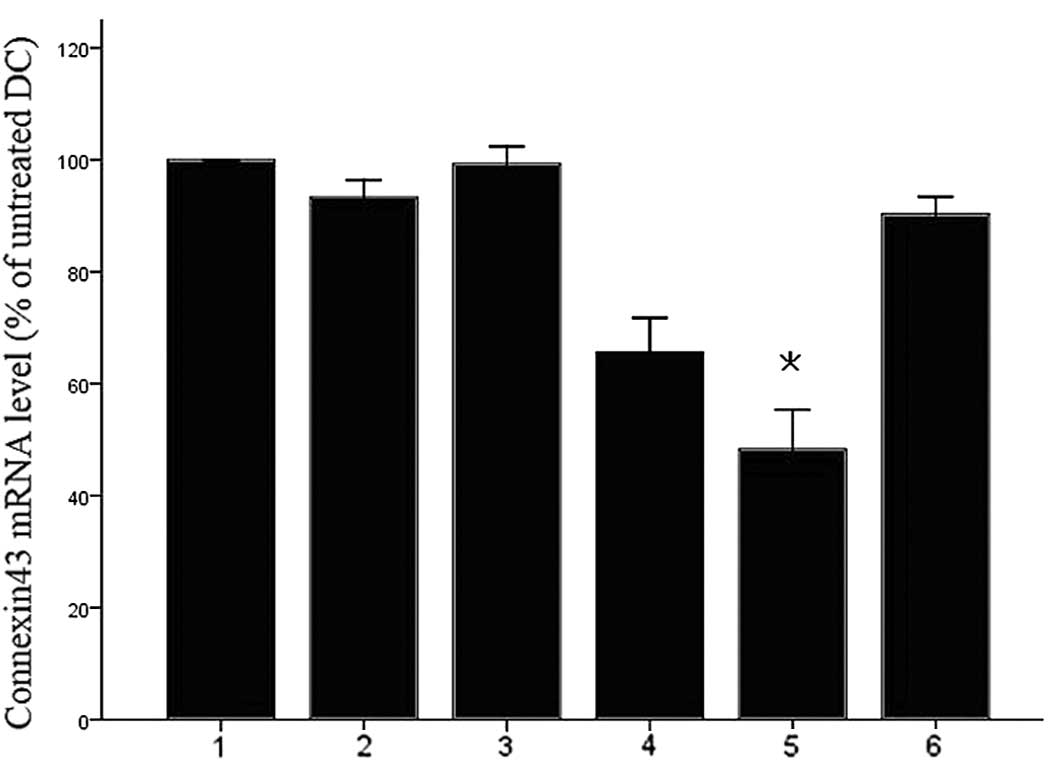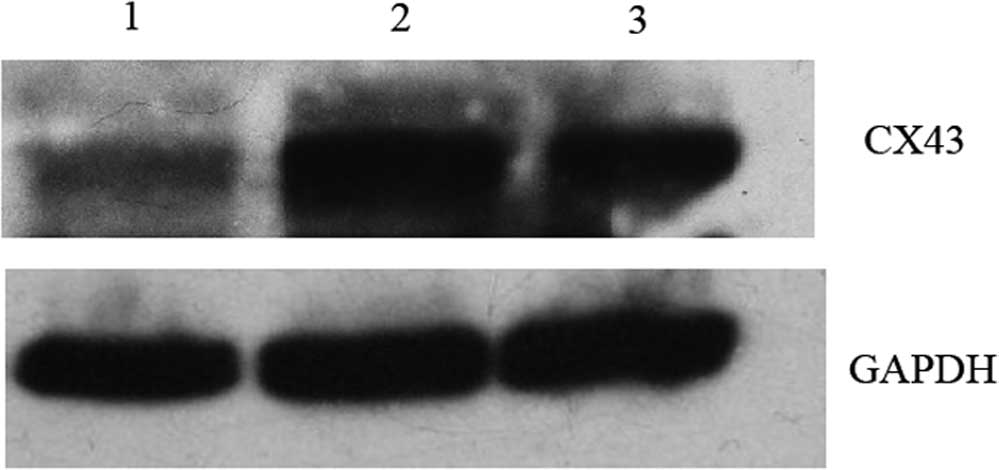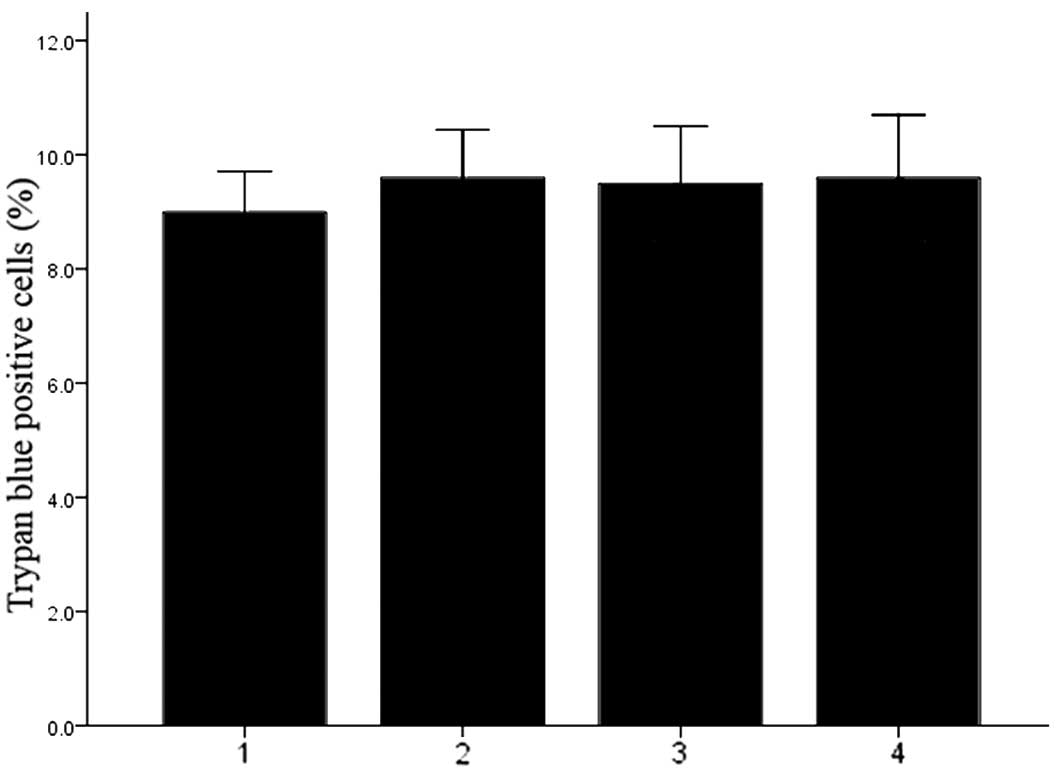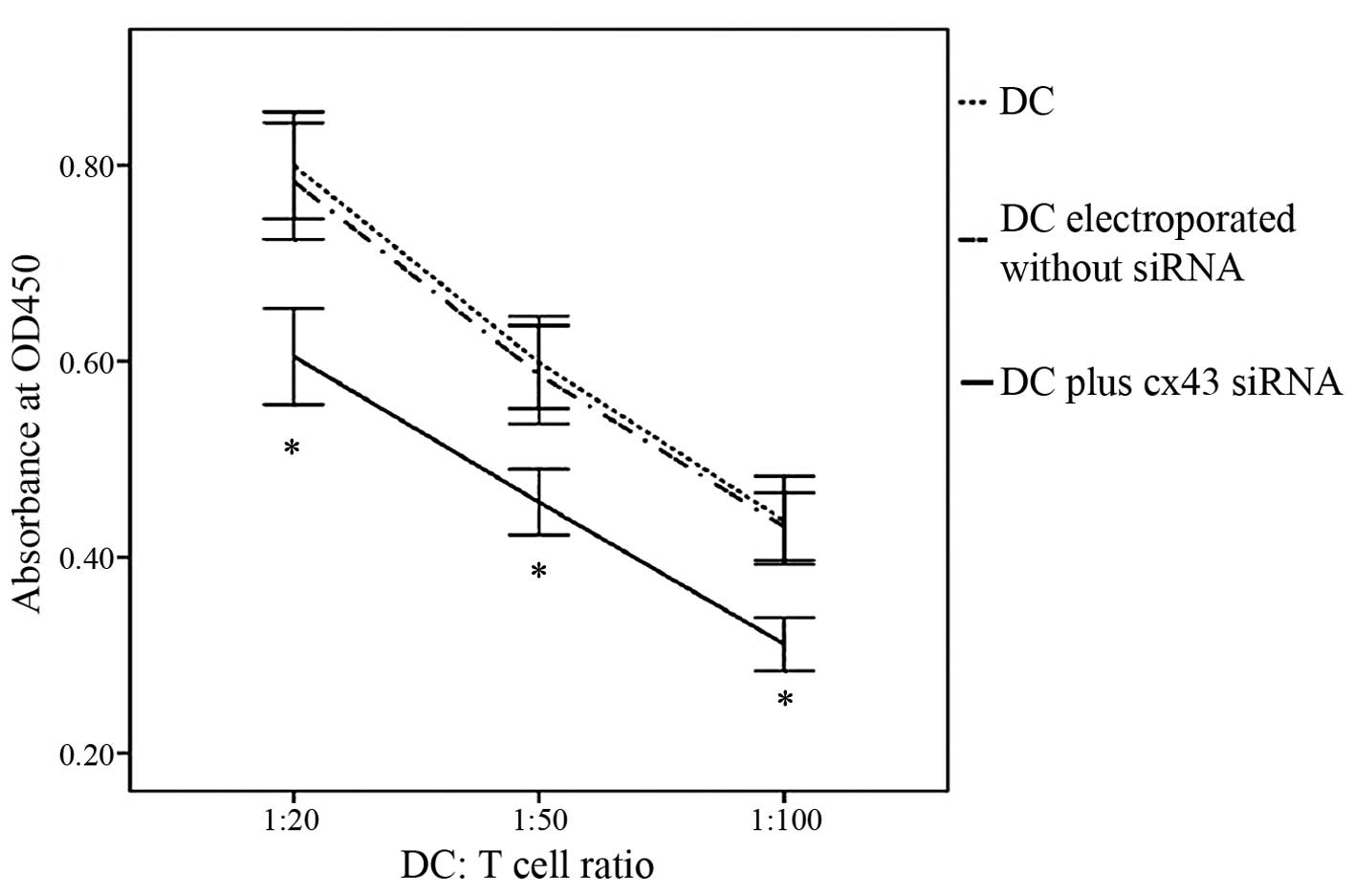Connexin43 knockdown in bone marrow‑derived dendritic cells by small interfering RNA leads to a diminished T-cell stimulation
- Authors:
- Published online on: November 20, 2015 https://doi.org/10.3892/mmr.2015.4593
- Pages: 895-900
Abstract
Introduction
As the most powerful antigen-presenting cell (APC), dendritic cells (DCs) have a critical role in the stimulation of immune tolerance. Upon capturing of antigens, DCs migrate to the lymph nodes and transfer antigenic epitopes to T cells, which leads to activation of T cells (1–3). The surface expression of major histocompatibility complex (MHC) and co-stimulatory molecules, including CD40, CD80 and CD86, are upregulated in DCs upon their functional transformation from 'tolerogenic' to 'immunogenic' DCs (4).
The gap junction is a specialized intercellular connection between a multitude of cell-types of higher organisms. Connexins (Cx) are members of a diverse family of proteins that are differentially produced by a number of cell types (5,6). Two connexin-based hemichannels are coupled to form a gap junction between two adjacent cells (7,8). Gap junctions formed by Cx (≤1 kDa in size) have an important role in transmitting signals between cells of the immune system (9–14). As one of the principal connexins in the immune system, the expression of connexin43 (Cx43) is upregulated in human monocytes and DCs at inflammatory sites to form gap junctions when immune cells are exposed to inflammatory factors (15). Neijssen et al (16) found that monocytes or DCs interacted with their environment to source metabolic or electronic information from the neighboring cells upon detecting inflammation. These results revealed a novel mechanism of cross-presentation through gap junctions. Therefore, suppression of Cx43 may be an important strategy for immune therapy.
RNA interference (RNAi), which sequence-specifically targets mRNAs with short double-stranded (ds)RNAs, has been successfully employed in various mammalian cell lines as well as in primary cells, including T lymphocytes and antigen-presenting cells. In previous studies, knockdown of various cytokines has successfully generated desired immune responses (17,18). DNA vectors, adenoviruses as well as lentiviruses have been widely applied for small interfering (si) RNA delivery into a variety of cell systems (19,20). Among the methods for the delivery of siRNA into DCs, chemical transfection (e.g. using lipid-based reagents) and viral vectors are routinely used (21,22). However, chemical transfection reagents are prone to causing allergic reactions and the application of lentiviral vectors may result in unspecific immune responses (23). In order to circumvent these undesired effects, a transfection method exclusively relying on physical reactions is urgently required to downregulate specific protein expression. Jantsch et al (24) previously established an electroporation protocol to deliver siRNA molecules into bone marrow-derived dendritic cells (BM-DCs) without affecting the immunoresponse of DCs.
The present study reported on the application an efficient method of electroporation to knock down Cx43 expression in BM-DCs by using siRNA. Three prospective dsRNAs targeting Cx43 were applied and reverse-transcription quantitative polymerase chain reaction (RT-qPCR) was used to identify the dsRNA with the most potent Cx43 knockdown ability following transfection under electroporation conditions. After knockdown of Cx43 expression, the surface antigens of DCs were assessed by flourescence-assisted cell sorting (FACS) and their capacity to activate T cells was evaluated using a mixed lymphocyte reaction (MLR). The results of the present study provided evidence that Cx43 has an important role in the immunomodulation of DCs.
Materials and methods
Generation of BM-DCs
A total of 20 adult male C57BL/6 and BALB/c mice (2 months old; weight, 25 g), obtained from the Animal Laboratory of Zhejiang University (Hangzhou, China) were raised under a 12-h light/dark cycle at 22±1°C, 60±5% humidity, and access to food and water ad libitum. The present study was approved by the ethics committee of the College of Medicine, Zhejiang University (Hangzhou, China).
The animals were sacrificed by decapitation under anesthesia with 1% sodium pentobarbital (Merck, Darmstadt, Germany). BM-DCs were generated from bone marrow progenitor cells according to the protocol of a previous study (25). Briefly, bone marrow cells were flushed from the femurs and tibias of C57BL/6 mice, followed by washing and culture in six-well plates (2×106 cells/ml) in 2 ml RPMI 1640 medium containing 2 mM l-glutamine and 10% fetal calf serum (FCS) (all from Gibco-BRL, Invitrogen Life Technologies, Inc., Carlsbad, CA, USA), supplemented with recombinant Granulocyte-macrophage colony-stimulating factor (GM-CSF; 20 ng/ml; PeproTech, Rocky Hill, NJ, USA) and recombinant mouse interleukin (IL)-4 (10 ng/ml; PeproTech). All cultures were incubated at 37°C in an incubator containing a humidified atmosphere with 5% CO2. After 48 h of culture, non-adherent granulocytes were removed by washing and fresh medium was added. DCs were cultured for six days as immature DCs. Activation with lipopolysaccharide (LPS; 100 ng/ml; Sigma-Aldrich, St. Louis, MO, USA) was performed after eight days of culture, and following 48 h, DCs differentiated into mature DCs (mDC).
siRNA synthesis
siRNA sequences were selected in accordance with a previously described method (26,27). Three sequences specific for the Cx43 gene were selected: Cx43-targeting dsRNA 1 (5′-CCCACCTTTGTGTCTTCCATA-3′), 2 (5′-GCAGATTGAAATCAAGAAGTT-3′) and 3 (5′-CCTGCTGAGAACCTACATCAT-3′). Non-silencing control siRNA (5′-TTCTCCGAACGTGTCACGT-3′) is an irrelevant siRNA with random nucleotides. All siRNAs were synthesized and annealed by Shanghai GeneChem Limited Co. (Shanghai, China).
Electroporation of DCs
DCs were harvested and washed with RPMI 1640 and phosphate-buffered saline at room temperature. The cells were suspended in optimized minimum essential medium (Opti-MEM; Invitrogen Life Technologies, Inc.) at a concentration of 4×107 cells/ml. 7.5 µg siRNA duplexes were transferred to a 4-mm cuvette (Tiancheng Company, Hangzhou, China) and filled up to a final volume of 100 µl with Opti-MEM. 100 µl cell suspension (containing 4×106 cells) was added and immediately pulsed using a Gene Pulser II apparatus (Bio-Rad Laboratories, Inc., Hercules, CA, US). Pulse conditions were 300 V, 150 µF and 100 Ω. Immediately after ~2 sec electroporation, the cells were transferred into medium supplemented with GM-CSF and IL-4.
RT-qPCR
After gene silencing, mRNA was extracted from DCs using TRIzol (Invitrogen Life Technologies, Inc.) according to the manufacturer's instructions. The SuperScript Pre-amplification system kit (Invitrogen Life Technologies, Inc.) was used for the generation of the first-strand cDNA. In brief, 0.5 µg oligo (dT) (12–18 bp) and 200 U SuperScript-2 reverse transcriptase were incubated with 2 µg DNA-free total RNA for 50 min at 42°C in the presence of 0.5 mM desoxynucleotide triphosphate, 10 mM dithiothreitol and 1X first-strand buffer. The following primers (Sangon Biotech Co., Ltd., Shanghai, China) were used: Cx43 (519 bp) sense, 5′-CCCCACTCTCACCTATGTCTCC-3′ and anti-sense, 5′-ACTTTTGCCGCCTAGCTATCCC-3′; and GAPDH (172 bp) sense, 5′-ATTCAACGGCACAGTCAAGG-3′ and anti-sense, 5′-GCAGAAGGGGCCGGAGATGA-3′. qPCR was performed on an ABI 7900 PCR Instrument (PerkinElmer, Inc., Waltham, MA, USA) in a 20 µl volume, using 5x Universal SYBR Green PCR Master Mix (Takara Bio Inc., Otsu, Japan). GAPDH was used as an internal control. PCR was performed based on following protocol: Initial denaturation at 95°C for 5 min, followed by 30 cycles of denaturation at 95°C for 0.5 min, re-naturation at 60°C for 0.5 min and extension at 72°C for 0.5 min, followed by a final extension at 72°C for 10 min. Results were obtained from at least three independent experiments performed in triplicate. The expression levels were quantified using the ΔΔCT method.
Cell viability assay
The cell viability after electroporation was determined using Trypan blue staining. Dendritic cells were collected 48 h after electroporation, stained with Trypan blue (Beyotime Institute of Biotechnology, Inc., Haimen, China) and counted using a hematocytometer (Hangzhou Kanna Tech Co. Ltd, Hangzhou, China). Four different populations of electroporated cells were generated: i) DC; ii) DC electroporated without siRNA; iii) DC electroporated with non-silencing control siRNA; iv) DC electroporated with Cx43-targeting siRNA 2.
Western blot analysis
DCs (4×106) were lysed in 150 µl lysis buffer containing 10% glycerol, 2 mM EDTA (pH 8.0), 0.5% Nonidet P-40, 137 mM NaCl and 50 mM Tris-HCl (pH 8.0) (Beyotime Institute of Biotechnology, Inc.). Protein concentration was determined using a bicinchoninic acid assay (Beyotime Institute of Biotechnology, Inc.) and 20 µg protein was separated using 12% SDS-PAGE following transfer onto a nitrocellulose membrane. The following primary antibodies were used for western blot analysis, and incubated at 4°C overnight: Mouse anti-Cx43 monoclonal antibody (mAb; Sigma-Aldrich; 1:8,000) and mouse anti-GAPDH mAb (clone 6c5, Kang Chen, China; 1:1,000). After incubation with goat anti-mouse horseradish peroxidase-labeled immunoglobulin G secondary antibodies (1:10,000, 2 h at room temperature), the blots were washed three times with phosphate-buffered saline for 10 min, signal detection was performed using an enhanced chemiluminescence western blotting substrate (Pierce Biotechnology, Inc., Rockford, IL, USA), and the blots were scanned using Bio-Rad ChemiDoc XRS (Bio-Rad Laboratories, Inc.).
Flow cytometric analysis
Phenotypic analysis of isolated or cultured DCs was performed on a FACScan flow cytometer (BD Biosciences, Franklin Lakes, NJ, USA). All antibodies (fluorescein isothiocyanate-conjugated anti-mouse CD40 and CD80 antibodies, and PE-conjugated anti-mouse MHC-II and CD86 antibodies) were purchased from eBioscience, Inc. (San Diego, CA, USA). DC subsets were analyzed by means of two- or three-color staining with various combinations of mouse antibodies. All FACS analyses were performed using appropriate isotype controls (eBioscience, Inc).
MLR analysis
DCs from the different experimental groups were treated with 30 µg/ml mitomycin C (Sigma-Aldrich) at 37°C for 1 h, washed twice with RPMI 1640 and seeded into flat-bottom 96-well culture plates (104/well) for use as stimulator cells. Recipient T cells (0.2−1×106/well) from BALB/c mice were added to the DCs in a total volume of 200 µl RPMI 1640 containing 10% FCS, followed by co-culture in a humidified atmosphere with 5% CO2 at 37°C for 72 h. 3 h prior to the end of the culture, Cell Counting kit-8 solution (Beyotime Institute of Biotechnology, Inc.) was added to each well of the plate (10 µl/well). At the end of the culture, the absorbance at 450 nm was measured using a microplate reader 3550 (Bio-Rad Laboratories, Inc.).
Statistical analysis
Values are expressed as the mean ± standard deviation. Statistical analysis was performed using SPSS 17.0 software (SPSS, Inc., Chicago, IL, USA). MLR and RT-qPCR data were analyzed using one-way analysis of variance followed by the Newman-Keuls test. P<0.05 was considered to indicate a statistically significant difference between values.
Results
Silencing of Cx43 in DCs
In order to identify an siRNA duplex that is able to reduce the expression of Cx43, three candidate dsRNAs were synthesized. Following dsRNA-mediated knockdown with electroporation, transcripts of Cx43 were detected by RT-qPCR. After transfection for 24 h, a marked downregulation of Cx43 mRNA levels in Cx43 dsRNA-transfected cells, but not in scrambled siRNA-transfected cells, was observed compared to that in the untreated DCs (Fig. 1). Cx43-targeting dsRNA 2 was the most effective siRNA to block Cx43 expression at the mRNA level. The protein levels of Cx43 were also detected in the transfection groups. Consistent with the effects on Cx43 mRNA expression, Cx43 protein was also significantly reduced after transfection with Cx43-targeting dsRNA 2 (Fig. 2).
Transfection of DCs with Cx43-targeting dsRNA under electroporation does not affect cell viability
The viability of DCs was determined by Trypan blue staining. As shown in Fig. 3, the viability was similar among all experimental groups, indicating that electroporation-mediated Cx43 knockdown did not affect the viability of DCs (P>0.05).
Transfection of DCs with Cx43-targeting dsRNA under electroporation decrease the expression of surface antigens
After six days of culture, transfected DCs were stimulated with LPS for 48 h and subsequently collected. The expression of surface co-stimulatory molecules was assessed by FACS analysis. The surface expression of CD40, CD80, MHC-II and CD86 on untreated DCs, DCs that were electroporated without siRNA and DCs that were electroporated in the presence of Cx43-targeting dsRNA was assessed following 48 h. As shown in Fig. 3, the fraction of cells expressing CD40, MHC-II, CD80 and CD86 was decreased in DCs with Cx43 knockdown compared with that in the other groups.
Cx43-knockdown DCs show a reduced capacity to stimulate T cells
In order to assess whether Cx43 knockdown affected the stimulatory effects of DCs on T-cell proliferation, an allogeneic MLR was performed. DCs that were electroporated in the presence of Cx43-targeting dsRNA 2 exhibited a markedly reduced capacity to stimulate T-cell proliferation compared with that of untreated DCs or those subjected to electroporation only (Fig. 5). These results demonstrated that Cx43 had a specific role in DC-mediated T-cell stimulation.
Discussion
In response to inflammatory reactions, DCs or monocytes/macrophages upregulate Cx43 expression and form gap junctions at the inflammation site in order to link and therefore aggregate cells of identical as well as of different types (15,16). A recent study by our group further supported that Cx43 has critical roles in mediating the maturation of DCs as well as T-cell stimulation.
Mendoza-Naranjo et al (28) reported that gap junction formation was inhibited by a specific Cx-mimetic peptide, which binds to Cx43 extracellular loop 1 at the plasma membrane surface, which hampered human DCs from acquiring melanoma antigens from adjacent cells and inhibited melanoma-specific T-cell activation. Consistently with these results, gap junction inhibitors also affected the antigen transfer between human DCs (29,30). These findings suggested that membrane expression of Cx43 in DCs is closely associated with antigen transfer. A further study revealed that Cx43 is required for correcting T-cell maturation as demonstrated in Cx43-deficient mice (31).
For treatment regimens of various conditions, including autoimmune diseases, organ transplantation and cancer, immunomodulation is critical. Since the immunogenic potential of DCs is among the most important factors in generating potent cytotoxic T lymphocytes (32), the development of strategies to suppress DCs is expected to improve current immunotherapies. siRNA-based knockdown of endogenous immunostimulatory factors is a promising strategy for modulation of the immunogenic functions of DCs for use in therapeutic strategies such as immunosuppression.
The present study described an efficient method to regulate Cx43 expression via electroporation-mediated siRNA transfection into immature DCs. A specific siRNA duplex was identified with the ability to knockdown Cx43 at the mRNA and protein level. Due to the fact that RNAi is a potent method that requires only a small number of dsRNA molecules per cell to silence repression, RNAi technology is superior to anti-sense oligonucleotide, genetic engineering or antibody-blocking approaches (32). Of note, under certain circumstances, siRNAs may directly stimulate immunity by initiating DC maturation (33,34); however, this is not a general effect of the siRNA but is dependent on the sequence of the duplex and is therefore considered to be an additional biological activity of siRNA. For this reason, these siRNAs are referred to as immunostimulatory siRNAs (isRNAs) (33). In the present study, a marginal increase in Cx43 mRNA expression levels in DCs transfected with non-silencing siRNA was demonstrated.
APCs acquire information in the form of antigens from infected cells in their periphery and subsequently migrate to lymph nodes to specifically stimulate cytotoxic T lymphocytes by antigen presentation and expression of specific co-stimulatory molecules, leading to the activation and expansion of the cytotoxic T-lymphocytes (35,36). Activated monocytes have been demonstrated to acquire antigenic information in the form of peptides from influenza-infected cells through the gap junction (16). The present study showed that knockdown of Cx43 in DCs significantly reduced their capacity to stimulate T-cell proliferation, thereby contributing to the elucidation of the function of Cx43 in DCs during the activation of T-cell proliferation.
The present study was the first to demonstrate that RNAi can be successfully applied to block Cx43 expression in DCs. siRNA-mediated silencing of Cx43 equipped DCs with 'tolerogenic' properties. This approach may be a promising strategy for immunotherapy.
Acknowledgments
The present study was supported by grants from the National Natural Science Foundation of China (no. 30670866).
References
|
Hart DN: Dendritic cells: Unique leukocyte populations which control the primary immune response. Blood. 90:3245–3287. 1997.PubMed/NCBI | |
|
Shortman K and Liu YJ: Mouse and human dendritic cell subtypes. Nat Rev Immunol. 2:151–161. 2002. View Article : Google Scholar : PubMed/NCBI | |
|
Mellman I and Steinman RM: Dendritic cells: Specialized and regulated antigen processing machines. Cell. 106:255–258. 2001. View Article : Google Scholar : PubMed/NCBI | |
|
Steinman RM, Hawiger D and Nussenzweig MC: Tolerogenic dendritic cells. Annu Rev Immunol. 21:685–711. 2003. View Article : Google Scholar : PubMed/NCBI | |
|
Bennett MV, Contreras JE, Bukauskas FF and Sáez JC: New roles for astrocytes: Gap junction hemichannels have something to communicate. Trends Neurosci. 26:610–617. 2003. View Article : Google Scholar : PubMed/NCBI | |
|
Saez JC, Berthoud VM, Branes MC, Martinez AD and Beyer EC: Plasma membrane channels formed by connexins: Their regulation and functions. Physiol Rev. 83:1359–1400. 2003. View Article : Google Scholar : PubMed/NCBI | |
|
Harris AL: Emerging issues of connexin channels: Biophysics fills the gap. Q Rev Biophys. 34:325–472. 2001. View Article : Google Scholar | |
|
Evans WH, De Vuyst E and Leybaert L: The gap junction cellular internet: Connexin hemichannels enter the signalling limelight. Biochem J. 397:1–14. 2006. View Article : Google Scholar : PubMed/NCBI | |
|
Krenács T and Rosendaal M: Immunohistological detection of gap junctions in human lymphoid tissue: Connexin43 in follicular dendritic and lymphoendothelial cells. J Histochem Cytochem. 43:1125–1137. 1995. View Article : Google Scholar : PubMed/NCBI | |
|
Krenacs T and Rosendaal M: Gap-junction communication pathways in germinal center reactions. Dev Immunol. 6:111–118. 1998. View Article : Google Scholar : PubMed/NCBI | |
|
Nihei OK, Campos de Carvalho AC, Spray DC, Savino W and Alves LA: A novel form of cellular communication among thymic epithelial cells: Intercellular calcium wave propagation. Am J Physiol Cell Physiol. 285:C1304–C1313. 2003. View Article : Google Scholar : PubMed/NCBI | |
|
Alves LA, Nihei OK, Fonseca PC, Carvalho AC and Savino W: Gap junction modulation by extracellular signaling molecules: The thymus model. Braz J Med Biol Res. 33:457–465. 2000. View Article : Google Scholar : PubMed/NCBI | |
|
Wong CW, Christen T and Kwak BR: Connexins in leukocytes: Shuttling messages? Cardiovasc Res. 62:357–367. 2004. View Article : Google Scholar : PubMed/NCBI | |
|
Oviedo-Orta E, Errington RJ and Evans WH: Gap junction intercellular communication during lymphocyte transendothelial migration. Cell Biol Int. 26:253–263. 2002. View Article : Google Scholar : PubMed/NCBI | |
|
Eugenín EA, Brañes MC, Berman JW and Sáez JC: TNF-alpha plus IFN-gamma induce connexin43 expression and formation of gap junctions between human monocytes/macrophages that enhance physiological responses. J Immunol. 170:1320–1328. 2003. View Article : Google Scholar : PubMed/NCBI | |
|
Neijssen J, Herberts C, Drijfhout JW, Reits E, Janssen L and Neefjes J: Cross-presentation by intercellular peptide transfer through gap junctions. Nature. 434:83–88. 2005. View Article : Google Scholar : PubMed/NCBI | |
|
Kumar P, Ban HS, Kim SS, Wu H, Pearson T, Greiner DL, Laouar A, Yao J, Haridas V, Habiro K, et al: T cell-specific siRNA delivery suppresses HIV-1 infection in humanized mice. Cell. 134:577–586. 2008. View Article : Google Scholar : PubMed/NCBI | |
|
Chhabra A, Chakraborty NG and Mukherji B: Silencing of endogenous IL-10 in human dendritic cells leads to the generation of an improved CTL response against human melanoma associated antigenic epitope, MART-1 27–35. Clin Immunol. 126:251–259. 2008. View Article : Google Scholar : PubMed/NCBI | |
|
El-Armouche A, Singh J, Naito H, Wittköpper K, Didié M, Laatsch A, Zimmermann WH and Eschenhagen T: Adenovirus-delivered short hairpin RNA targeting PKCalpha improves contractile function in reconstituted heart tissue. J Mol Cell Cardiol. 43:371–376. 2007. View Article : Google Scholar : PubMed/NCBI | |
|
Baba K, Goto-Koshino Y, Mizukoshi F, Setoguchi-Mukai A, Fujino Y, Ohno K and Tsujimoto H: Inhibition of the replication of feline immunodeficiency virus by lentiviral vector-mediated RNA interference in feline cell lines. J Vet Med Sci. 70:777–783. 2008. View Article : Google Scholar : PubMed/NCBI | |
|
Liu G, Ng H, Akasaki Y, Yuan X, Ehtesham M, Yin D, Black KL and Yu JS: Small interference RNA modulation of IL-10 in human monocyte-derived dendritic cells enhances the Th1 response. Eur J Immunol. 34:1680–1687. 2004. View Article : Google Scholar : PubMed/NCBI | |
|
Chen X, He J and Chang LJ: Alteration of T cell immunity by lentiviral transduction of human monocyte-derived dendritic cells. Retrovirology. 1:–37. 2004. View Article : Google Scholar : PubMed/NCBI | |
|
Prechtel AT, Turza NM, Theodoridis AA, Kummer M and Steinkasserer A: Small interfering RNA (siRNA) delivery into monocyte-derived dendritic cells by electroporation. J Immunol Methods. 311:139–152. 2006. View Article : Google Scholar : PubMed/NCBI | |
|
Jantsch J, Turza N, Volke M, Eckardt KU, Hensel M, Steinkasserer A, Willam C and Prechtel AT: Small interfering RNA (siRNA) delivery into murine bone marrow-derived dendritic cells by electroporation. J Immunol Methods. 337:71–77. 2008. View Article : Google Scholar : PubMed/NCBI | |
|
Sumimoto H, Tsuji T, Miyoshi H, Hagihara M, Takada-Yamazaki R, Okamoto S, Ikeda Y, Takahashi T and Kawakami Y: Rapid and efficient generation of lentivirally gene-modified dendritic cells from DC progenitors with bone marrow stromal cells. J Immunol Methods. 271:153–165. 2002. View Article : Google Scholar : PubMed/NCBI | |
|
Elbashir SM, Harborth J, Lendeckel W, Yalcin A, Weber K and Tuschl T: Duplexes of 21-nucleotide RNAs mediate RNA interference in cultured mammalian cells. Nature. 411:494–498. 2001. View Article : Google Scholar : PubMed/NCBI | |
|
Matsue H, Yao J, Matsue K, Nagasaka A, Sugiyama H, Aoki R, Kitamura M and Shimada S: Gap junction-mediated intercellular communication between dendritic cells (DCs) is required for effective activation of DCs. J Immunol. 176:181–190. 2006. View Article : Google Scholar | |
|
Mendoza-Naranjo A, Saéz PJ, Johansson CC, Ramírez M, Mandakovic D, Pereda C, López MN, Kiessling R, Sáez JC and Salazar-Onfray F: Functional gap junctions facilitate melanoma antigen transfer and cross-presentation between human dendritic cells. J Immunol. 178:6949–6957. 2007. View Article : Google Scholar : PubMed/NCBI | |
|
Guan X, Cravatt BF, Ehring GR, Hall JE, Boger DL, Lerner RA and Gilula NB: The sleep-inducing lipid oleamide deconvolutes gap junction communication and calcium wave transmission in glial cells. J Cell Biol. 139:1785–1792. 1997. View Article : Google Scholar | |
|
Guan X, Wilson S, Schlender KK and Ruch RJ: Gap-junction disassembly and connexin 43 dephosphorylation induced by 18 beta-glycyrrhetinic acid. Mol Carcinog. 16:157–164. 1996. View Article : Google Scholar : PubMed/NCBI | |
|
Montecino-Rodriguez E, Leathers H and Dorshkind K: Expression of connexin 43 (Cx43) is critical for normal hemato-poiesis. Blood. 96:917–924. 2000.PubMed/NCBI | |
|
Ichim TE, Zhong R and Min WP: Prevention of allograft rejection by in vitro generated tolerogenic dendritic cells. Transpl Immunol. 11:295–306. 2003. View Article : Google Scholar : PubMed/NCBI | |
|
Hornung V, Guenthner-Biller M, Bourquin C, Ablasser A, Schlee M, Uematsu S, Noronha A, Manoharan M, Akira S, de Fougerolles A, et al: Sequence-specific potent induction of IFN-alpha by short interfering RNA in plasmacytoid dendritic cells through TLR7. Nat Med. 11:263–270. 2005. View Article : Google Scholar : PubMed/NCBI | |
|
Prechtel AT, Turza NM, Theodoridis AA and Steinkasserer A: CD83 knockdown in monocyte-derived dendritic cells by small interfering RNA leads to a diminished T cell stimulation. J Immunol. 178:5454–5464. 2007. View Article : Google Scholar : PubMed/NCBI | |
|
Randolph GJ, Sanchez-Schmitz G and Angeli V: Factors and signals that govern the migration of dendritic cells via lymphatics: Recent advances. Springer Semin Immunopathol. 26:273–287. 2005. View Article : Google Scholar | |
|
Sumen C, Mempel TR, Mazo IB and von Andrian UH: Intravital microscopy: Visualizing immunity in context. Immunity. 21:315–329. 2004.PubMed/NCBI |













